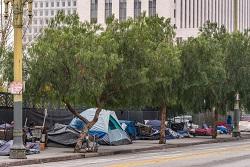Caution Is Needed When Considering "Sanctioned Encampments" or "Safe Zones"
 We know communities are working to address the immediate safety and living conditions of people who are unsheltered, and some are considering sanctioned encampments or safe zones as a part of their response.
We know communities are working to address the immediate safety and living conditions of people who are unsheltered, and some are considering sanctioned encampments or safe zones as a part of their response.
In this document, we consider some of the costs and consequences of such settings and their potential impact on a community's systemic efforts to end homelessness.
|
Coalition Brings Together Partners to Reduce Homelessness Among American Indians/Alaska Natives
 American Indians/Alaska Natives are disproportionately affected by homelessness, yet they are least likely to be referred to or accepted into housing programs.
American Indians/Alaska Natives are disproportionately affected by homelessness, yet they are least likely to be referred to or accepted into housing programs.
Colleen Echohawk, Director of the Chief Seattle Club, explains how a culturally competent system will ensure a broader and more effective response to indigenous homelessness
.
|
New Resources for Communities Serving Youth Experiencing Homelessness
 Tap into these resources for youth experiencing homelessness: Tap into these resources for youth experiencing homelessness:
The National Clearinghouse on Homeless Youth and Families has launched a new website and blog, providing resources for
communities serving runaway and homeless youth.
A new publication from USICH provides information about a range of federal programs that can support efforts to prevent and end homelessness, including youth homelessness.
|
Voices of Youth Count Issues Research Brief on Pregnant and Parenting Youth Experiencing
The brief relates some of the trends and unique challenges faced by young people who are pregnant or parenting and don't have a safe and stable place to live.
|
Congratulations to Kittitas County on becoming the first community in Washington to effectively end Veteran homelessness!
|
|
|
|
|